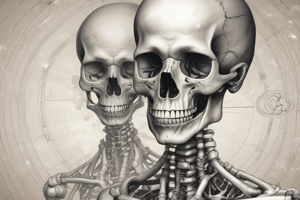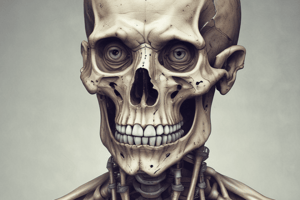Podcast
Questions and Answers
What condition is characterized by mutations in the fibroblast growth factor receptor 3 (FGFR3)?
What condition is characterized by mutations in the fibroblast growth factor receptor 3 (FGFR3)?
- Osteogenesis Imperfecta
- Dysostosis
- Achondroplasia (correct)
- Dysplasia
Which condition primarily affects the synthesis of type I collagen?
Which condition primarily affects the synthesis of type I collagen?
- Dysplasia
- Osteogenesis Imperfecta (correct)
- Achondroplasia
- Osteoporosis
What is a common physical characteristic of individuals with achondroplasia?
What is a common physical characteristic of individuals with achondroplasia?
- Long extremities
- Normal trunk length (correct)
- Small head circumference
- Shortened proximal extremities (correct)
Which of the following is NOT a typical feature of Osteogenesis Imperfecta?
Which of the following is NOT a typical feature of Osteogenesis Imperfecta?
Dysostoses are primarily a result of abnormalities in what process?
Dysostoses are primarily a result of abnormalities in what process?
Hearing loss in Osteogenesis Imperfecta is primarily related to which of the following?
Hearing loss in Osteogenesis Imperfecta is primarily related to which of the following?
What is the primary reason for the extreme skeletal fragility in Osteogenesis Imperfecta?
What is the primary reason for the extreme skeletal fragility in Osteogenesis Imperfecta?
Which type of congenital abnormality involves global disorganization of bone and/or cartilage?
Which type of congenital abnormality involves global disorganization of bone and/or cartilage?
What primary factor contributes to dental imperfections associated with osteogenesis imperfecta (OI)?
What primary factor contributes to dental imperfections associated with osteogenesis imperfecta (OI)?
Which form of osteopetrosis is often fatal in infants due to leukopenia?
Which form of osteopetrosis is often fatal in infants due to leukopenia?
What is the characteristic skeletal change in osteopetrosis?
What is the characteristic skeletal change in osteopetrosis?
Which of the following is not associated with osteopetrosis?
Which of the following is not associated with osteopetrosis?
Which bacteria is most commonly associated with acute pyogenic osteomyelitis?
Which bacteria is most commonly associated with acute pyogenic osteomyelitis?
What symptom may indicate mild osteopetrosis in adolescents or adults?
What symptom may indicate mild osteopetrosis in adolescents or adults?
What process does osteopetrosis primarily interfere with?
What process does osteopetrosis primarily interfere with?
What is a common cause of osteomyelitis?
What is a common cause of osteomyelitis?
What is the most common route through which organisms reach the bone causing osteomyelitis?
What is the most common route through which organisms reach the bone causing osteomyelitis?
Which bacteria are significant causes of acute osteomyelitis in neonates?
Which bacteria are significant causes of acute osteomyelitis in neonates?
What is the term for the non-viable bone that becomes necrotic due to infection?
What is the term for the non-viable bone that becomes necrotic due to infection?
Which of the following can lead to the formation of a subperiosteal abscess in children?
Which of the following can lead to the formation of a subperiosteal abscess in children?
What is a common symptom of osteomyelitis?
What is a common symptom of osteomyelitis?
What complication can arise from chronic osteomyelitis that leads to a significant risk of serious illness?
What complication can arise from chronic osteomyelitis that leads to a significant risk of serious illness?
Which inflammatory response is stimulated by cytokines released from leukocytes during osteomyelitis?
Which inflammatory response is stimulated by cytokines released from leukocytes during osteomyelitis?
What is a rare but serious potential malignancy that can develop from chronic osteomyelitis?
What is a rare but serious potential malignancy that can develop from chronic osteomyelitis?
Flashcards
Dysostosis
Dysostosis
Localized problems with mesenchyme condensation and differentiation, leading to improper bone formation.
Congenital skeletal abnormalities
Congenital skeletal abnormalities
Inherited or developmental variations in bone structure, often from mesenchyme migration issues or overall bone/cartilage disorganization.
Dysplasia
Dysplasia
Global problems with skeletal development, affecting the whole skeleton due to gene mutations controlling development and remodeling.
Achondroplasia
Achondroplasia
Signup and view all the flashcards
Osteogenesis Imperfecta
Osteogenesis Imperfecta
Signup and view all the flashcards
Type I collagen deficiency
Type I collagen deficiency
Signup and view all the flashcards
Fragile bones (Osteogenesis Imperfecta)
Fragile bones (Osteogenesis Imperfecta)
Signup and view all the flashcards
Blue sclerae
Blue sclerae
Signup and view all the flashcards
Dental imperfections (OI)
Dental imperfections (OI)
Signup and view all the flashcards
Osteopetrosis (Marble Bone)
Osteopetrosis (Marble Bone)
Signup and view all the flashcards
Osteoclast function in bone resorption
Osteoclast function in bone resorption
Signup and view all the flashcards
Osteopetrosis symptoms in bones
Osteopetrosis symptoms in bones
Signup and view all the flashcards
Infant Osteopetrosis prognosis
Infant Osteopetrosis prognosis
Signup and view all the flashcards
Osteomyelitis
Osteomyelitis
Signup and view all the flashcards
Acute Osteomyelitis
Acute Osteomyelitis
Signup and view all the flashcards
Pyogenic Osteomyelitis
Pyogenic Osteomyelitis
Signup and view all the flashcards
Osteomyelitis Causative Agent
Osteomyelitis Causative Agent
Signup and view all the flashcards
Osteomyelitis Routes
Osteomyelitis Routes
Signup and view all the flashcards
Osteomyelitis Morphology: Sequestrum
Osteomyelitis Morphology: Sequestrum
Signup and view all the flashcards
Osteomyelitis Morphology: Involucrum
Osteomyelitis Morphology: Involucrum
Signup and view all the flashcards
Osteomyelitis: Periosteal Abscesses
Osteomyelitis: Periosteal Abscesses
Signup and view all the flashcards
Osteomyelitis Clinical Features
Osteomyelitis Clinical Features
Signup and view all the flashcards
Chronic Osteomyelitis Complications
Chronic Osteomyelitis Complications
Signup and view all the flashcards
Osteomyelitis: Malignancy
Osteomyelitis: Malignancy
Signup and view all the flashcards
Study Notes
Congenital Abnormalities of the Skeleton
- Frequently result from inherited mutations
- Spectrum of developmental disorders
- Localized abnormalities in migration and condensation of mesenchyme (dysostosis)
- Global disorganization of bone and/or cartilage (dysplasia)
- Dysostoses result from defects in mesenchymal condensations and their differentiation
- Common forms include complete absence of a bone/digit (aplasia), extra bones/digits (supernumerary digit)
- Dysplasia results from mutations in genes controlling development/remodeling of the entire skeleton
- Common dysplasia examples include achondroplasia and osteogenesis imperfecta
Achondroplasia
- Most common skeletal dysplasia, major cause of dwarfism
- Autosomal dominant disorder
- Results from retarded cartilage growth
- Caused by gain-of-function mutations in fibroblast growth factor receptor 3 (FGFR3)
- Normally, FGF inhibits endochondral growth
- FGFR3 mutation creates a constitutively active receptor, exaggerating this effect and suppressing growth
- Affected individuals have shortened proximal extremities, relatively normal-length trunk, enlarged head with bulging forehead and nose depression
- Growth plate abnormalities are observed; proliferation zones are narrow and disorganized
Osteogenesis Imperfecta (OI)
- Common inherited disorder of connective tissue
- Caused by deficiencies in the synthesis of type I collagen
- Affects bone and other tissues rich in type I collagen (joints, eyes, ears, skin, and teeth)
- Typically results from autosomal dominant mutations in genes encoding type I collagen chains (al and a2 chains)
- Defects cause misfolding of mutated collagen polypeptides
- Key features include:
- Excessive skeletal fragility
- Blue sclerae due to decreased collagen content, allowing visualization of the underlying choroid
Hearing Loss and Dental Imperfections
- Hearing loss due to sensorineural deficits and conduction impairment in the middle ear bones
- Dental imperfections characterized by small, misshapen, and blue-yellow teeth, resulting from dentin deficiencies
Osteopetrosis
- Also known as marble bone disease
- Rare genetic diseases characterized by reduced bone resorption due to impaired osteoclast function
- Results in diffuse symmetric skeletal sclerosis (hardening)
- Bone has a stone-like quality, but is abnormally brittle and fracture easily
- Classified into variants based on inheritance and clinical severity
- Mutations interfere with osteoclast resorption of calcium hydroxyapatite within the matrix
- Bones lack a medullary canal; neural foramina are small and compressed.
- Severe infantile form is often fatal
Inflammatory Lesions of the Bones
- Inflammatory lesions/osteomyelitis are synonymous with infection
- Most common etiologic agents are pyogenic bacteria and Mycobacterium tuberculosis
- Bacteria reach the bone through hematogenous dissemination, extension of adjacent tissue infections, or traumatic implantation
- Inflammation, cell death (sequestrum), and bone destruction result
- Can be primary (isolated infection) or secondary to systemic infection (spread from other site)
- Chronic forms can lead to complications like pathologic fractures, secondary amyloidosis, or malignancy
Pyogenic Osteomyelitis
- Most cases are bacterial, with Staphylococcus aureus being most frequent
- Bacteria reach the bone through hematogenous spread, extension, or trauma
- Infection induces an acute inflammatory reaction leading to bone necrosis (sequestrae) and inflammation
- Subperiosteal abscesses may form and spread along the bone
- Bone resorption, fibrous tissue growth, and bone formation can follow
- Clinical features include fever, leukocytosis, pain over affected area (subtle in adults; often delayed diagnosis)
Tuberculous Osteomyelitis
- Mycobacterial infection, often complicating pulmonary tuberculosis
- Organisms typically reach the bone through the bloodstream, targeting long bones and vertebrae
- Chronic inflammatory process with caseous necrosis and extensive bone destruction
- Vertebral tuberculosis can lead to vertebral deformity, collapse, and posterior displacement (Pott disease)
- Potential for neurologic deficits
Studying That Suits You
Use AI to generate personalized quizzes and flashcards to suit your learning preferences.




